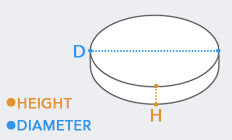Neodymium Disc Magnet - 6mm x 3mm |
good
Product code: 20071A


Prices are GST Incl.
Request a Quote for Bulk OrdersAustralia's Leading Supplier
Shipping Worldwide*
30 Day Returns
Same Day Dispatch*

This Disc Magnet uses powerful Rare Earth magnetic material. This allows for a strong magnetic force for its compact size. This disc magnet also has its North Pole marked for easy identification. This rare earth disc has a diameter of 6mm and a height of 3mm. It has a magnetic flux reading of 4455 Gauss and a pull force of 807 grams. It is identified by the AMF magnet part number 20071A.
This Neodymium Rare Earth Magnetic Disc has a small mark on one side delineating the North Polarity. This demarcation allows for easy and quick identification of the magnetic aspect of each magnet when using multiple together. The North Pole marking makes handling and storing the magnets effortless.
This marking lessens the chance of magnets being damaged in handling when they accidentally snap back together with force. Furthermore, it provides increased safety for those handling magnets by reducing the risk of pinching skin as the magnets pull together unexpectedly. The user can both visually see the marking and feel the mark tactilely.
For applications such as repetitive manufacturing, this marking is essential to prevent accidental inversion of the poles. Incorrect positioning of magnets could cause large-scale manufacturing to be brought to a standstill or event product malfunction post production.
No FAQ available

This Disc Magnet uses powerful Rare Earth magnetic material. This allows for a strong magnetic force for its compact size. This disc magnet also has its North Pole marked for easy identification. This rare earth disc has a diameter of 6mm and a height of 3mm. It has a magnetic flux reading of 4455 Gauss and a pull force of 807 grams. It is identified by the AMF magnet part number 20071A.
This Neodymium Rare Earth Magnetic Disc has a small mark on one side delineating the North Polarity. This demarcation allows for easy and quick identification of the magnetic aspect of each magnet when using multiple together. The North Pole marking makes handling and storing the magnets effortless.
This marking lessens the chance of magnets being damaged in handling when they accidentally snap back together with force. Furthermore, it provides increased safety for those handling magnets by reducing the risk of pinching skin as the magnets pull together unexpectedly. The user can both visually see the marking and feel the mark tactilely.
For applications such as repetitive manufacturing, this marking is essential to prevent accidental inversion of the poles. Incorrect positioning of magnets could cause large-scale manufacturing to be brought to a standstill or event product malfunction post production.
No FAQ available

The Pull Force listed for each magnet is based on lifting 10mm thick steel from a horizontal surface. Magnets on a vertical surface (of 10mm thick steel) are generally able to hold around only 30% of the pull force listed in the product description. This is due to the effects of gravity and the lack of friction between the surface and the shiny magnet. Read More